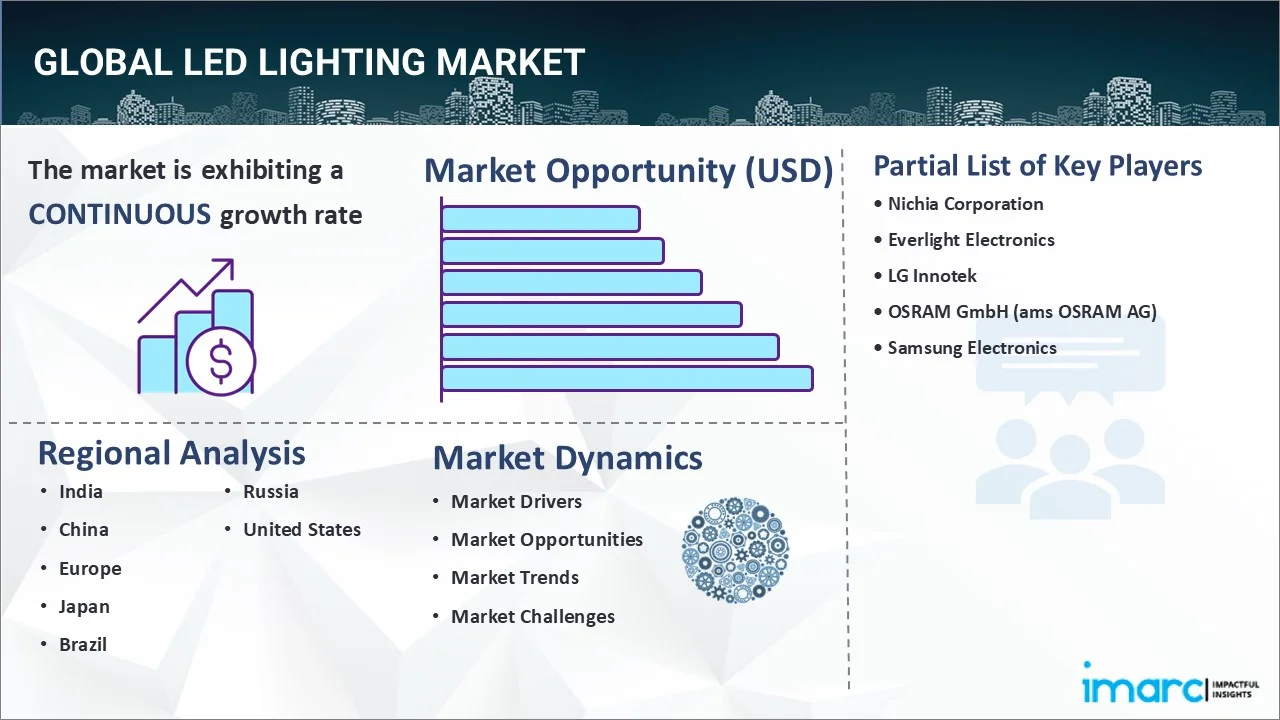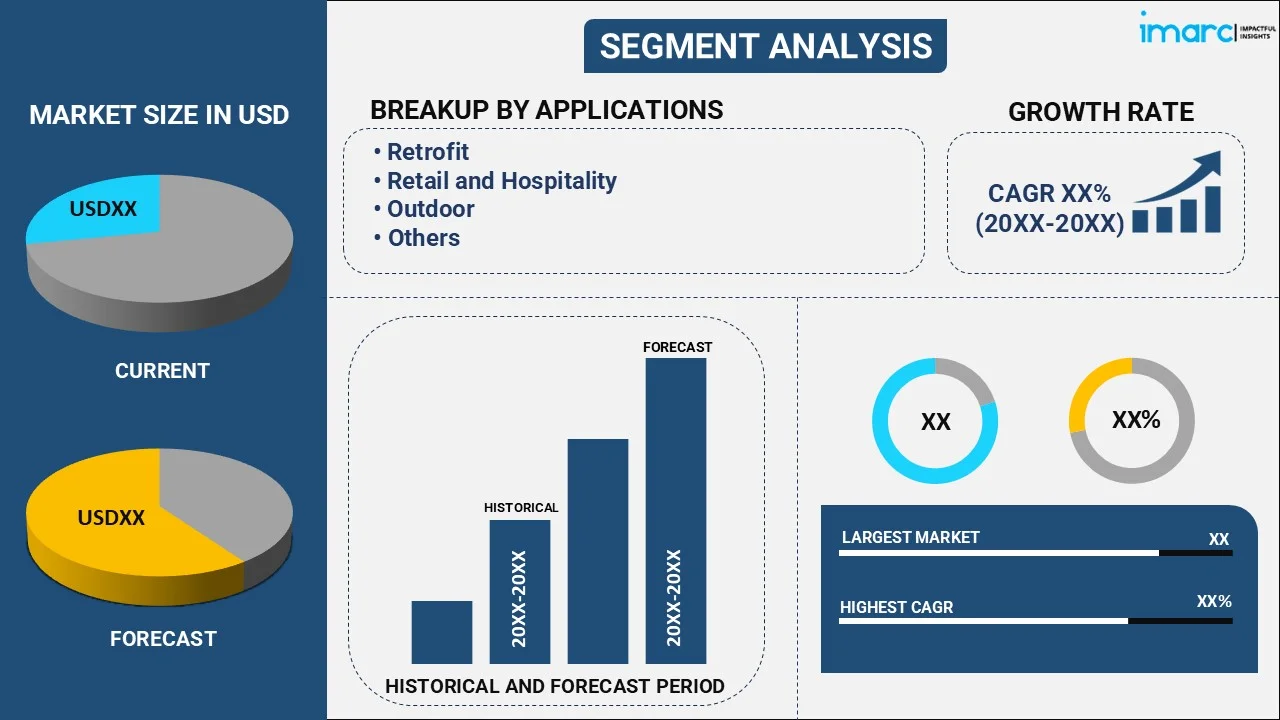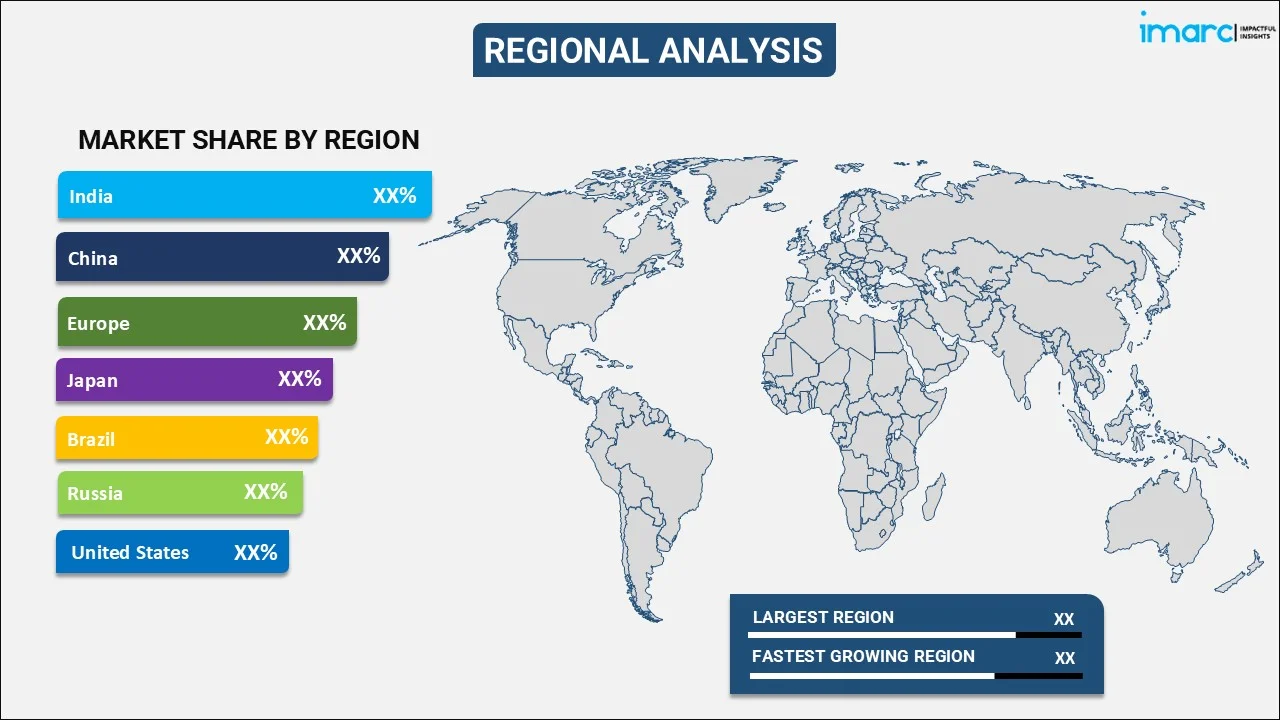
LED Lighting Market Report by Application (Retrofit, Retail and Hospitality, Outdoor, Offices, Architectural, Homes, Industrial), and Region 2025-2033
Global LED Lighting Market:
The global LED lighting market size reached USD 90.3 Billion in 2024. Looking forward, IMARC Group expects the market to reach USD 183.7 Billion by 2033, exhibiting a growth rate (CAGR) of 8.2% during 2025-2033. The growing demand for energy-efficient and cost-saving lighting solutions, rising environmental concerns among individuals, and favorable government initiatives to reduce emissions are some of the major factors propelling the market.
|
Report Attribute
|
Key Statistics
|
|---|---|
|
Base Year
|
2024 |
|
Forecast Years
|
2025-2033 |
|
Historical Years
|
2019-2024
|
|
Market Size in 2024
|
USD 90.3 Billion |
|
Market Forecast in 2033
|
USD 183.7 Billion |
|
Market Growth Rate 2025-2033
|
8.2% |
LED Lighting Market Analysis:
- Major Market Drivers: The increasing consumer environmental concerns are prompting a shift towards energy-efficient lighting solutions, such as LED lighting solutions. Moreover, as they have a longer lifespan and lower energy consumption, the global LED lighting market demand is elevating significantly. Besides this, the rising popularity of customizable and aesthetically pleasing lighting solutions in commercial, residential, and industrial sectors is expected to bolster the LED lighting market revenue.
- Key Market Trends: The LED bulb industry's top manufacturers are focusing on integrating advanced technologies to improve efficiency, minimize costs, and enhance their appeal to businesses and customers which is acting as one of the significant trends driving the market growth. Besides this, the development of smart lighting systems, where LEDs can be easily controlled via smartphones and other devices, is also fueling the LED lighting market across the globe.
- Competitive Landscape: Some of the leading LED lighting market companies include Nichia Corporation, Everlight Electronics, LG Innotek, OSRAM GmbH (ams OSRAM AG), and Samsung Electronics, among many others.
- Geographical Trends: According to the LED lighting market report, China held the biggest market share, as it is the manufacturing powerhouse for the LED lighting industry. In addition, rising technological advancements in LED lighting for improved efficiency are propelling the growth of the market.
- Challenges and Opportunities: The supply chain of LED lighting solutions is complex and often requires sourcing from various countries. Consequently, disruptions in the supply chain, owing to trade disputes and geopolitical tensions, can lead to product shortages and increased costs, thereby hindering the market growth. Furthermore, the rising number of large key players can also lead to challenges in standardizing LED lighting. However, numerous factors, such as favorable regulatory policies, strategic innovations, and the escalating need for energy-efficient lighting solutions, are some of the LED lighting market recent opportunities, which will continue to drive the growth of the market in the coming years.

LED Lighting Market Trends:
Rising Demand for Energy-Efficient and Cost-Saving Lighting Solutions
The escalating demand for energy-efficient and cost-effective lighting solutions among the masses across the world is primarily propelling the LED lighting market demand. LEDs convert a higher percentage of electrical energy into light, which saves a significant amount of energy. Individuals and government authorities across the globe are focusing on energy efficiency. Consequently, various leading companies are widely using LED lighting solutions, which is propelling the LED lighting market demand. Additionally, numerous concerned regulatory authorities of various developing nations are taking initiatives to build sustainable and energy-efficient cities, which is further catalyzing the market for LED lights. For instance, GSMA estimated that China may account for around 4.1 billion IoT connections, which is almost one-third of the worldwide IoT connections, by 2025. In line with this, in February 2023, Signify helped the German municipality of Eichenzell become a future-proof smart city through a smart street lighting solution. Its BrightSites solution enabled Eichenzell to cater to next-generation IoT applications and future 5G densification. Signify installed LED lighting, which the Interact City System manages. Eichenzell can continuously monitor and manage all lights from a single dashboard. Furthermore, in January 2023, Savant company GE Lighting announced the expansion of its smart home ecosystem, called Cync. Cync launched its entire Dynamic Effects entertainment lineup, which included 16 million presets, colors, custom light shows, on-device music syncing, and other features. Such initiatives are projected to propel the LED lighting market share in the coming years.
Increasing Environmental Concerns Among Individuals
The growing adoption of LED lighting on account of the increasing environmental awareness among individuals and government authorities is further catalyzing the market for LED lighting solutions. People are increasingly preferring sustainable lighting solutions that assist in reducing pollution in the environment. Considering this, various key manufacturers are introducing sustainable and energy-efficient lighting solutions. For instance, in July 2023, Signify Malaysia introduced a whole range of sustainable and energy-efficient lighting products for the Malaysian market. These products included Philips Ultra Efficient LED and Philips Solar Lighting solutions. Philips Ultra Efficient LED has advanced LED design and optics technology, consisting of a range of LED bulbs and LED tubes that consume 60% less energy than standard LED products of the same category. Moreover, it could deliver up to 50,000 hours of light and more than 3.5x the lifetime usage. In line with this, the Philips Solar Lighting range has a selection of solar products, such as solar wall lights, solar flood lights, solar garden or landscape lighting products, and others. Similarly, government bodies across the world are also making significant investments in upgrading the lighting infrastructure and installing environment-friendly lighting solutions. For instance, in June 2023, government bodies in the United States collaborated with the U.S. Department of Energy (DOE) to facilitate energy enhancements in K-12 schools nationwide. They have funded US$ 178 Million. This financial support helped these education facilities to undertake projects that were focused on minimizing energy expenditures, reducing emissions levels, and developing enhanced LED lighting solutions.
Favorable Government Initiatives
Governing agencies of various countries are encouraging the adoption of energy-efficient lighting solutions to curb pollution in the environment. They are introducing energy saving and tax benefits. For instance, the Indonesian government issued a 2015 Government Regulation No. 18, a series of preferential tax policies to attract domestic and foreign investment for LED, thereby providing low-cost consumer purchases. Similarly, Japan planned to implement Japan's Intended Nationally Determined Contributions (INDCs) draft to achieve at least a 50% reduction of global GHG emissions by 2050. This can be achieved by increasing the utilization of LED bulbs and other LED lighting solutions. Besides this, the government entities of North America are extensively investing in connected streetlights. Numerous communities in the region have already benefited from street and roadway lighting projects. For instance, Grand Rapids city council members approved a US$ 9.46 Million contract in February 2021 to upgrade all of the city's street lights to LEDs.
Global LED Lighting Industry Segmentation:
IMARC Group provides an analysis of the key trends in each segment of the global LED lighting market report, along with forecasts at the global, regional and country levels from 2025-2033. Our report has categorized the market based on application.
Breakup by Application:

- Retrofit
- Retail and Hospitality
- Outdoor
- Offices
- Architectural
- Homes
- Industrial
Retrofit represents the largest market segment
The report has provided a detailed breakup and analysis of the market based on the application. This includes retrofit, retail and hospitality, outdoor, offices, architectural, homes, and industrial. According to the report, retrofit represented the largest segment.
Retrofit application refers to the replacement of existing lighting fixtures with LED lighting solutions. In this, traditional lighting technologies, such as incandescent, fluorescent, and halogen bulbs, are replaced with energy-efficient LED alternatives. In addition, retrofitting offers a cost-effective way to upgrade lighting systems without changing the entire infrastructure.
Breakup by Region:

- India
- China
- Europe
- Japan
- Brazil
- Russia
- United States
China exhibits a clear dominance, accounting for the largest LED lighting market share
The report has also provided a comprehensive analysis of all the major regional markets, which include India, China, Europe, United States, Japan, Brazil, and Russia. According to the report, China accounted for the largest market share.
China held the biggest market share, as it is the manufacturing powerhouse for the LED lighting industry. China exports most of its LED lighting to other APAC countries, making it the world's largest LED lighting exporter. Apart from this, governing agencies in the country are rapidly promoting the adoption of LED lighting by offering various incentives and subsidies, which are supporting the growth of the market. Additionally, the growing demand for LED lighting in residential areas is positively influencing the market in China.
Competitive Landscape:
The report has provided a comprehensive analysis of the competitive landscape in the market. Detailed profiles of all major companies have also been provided. Some of the key players in the market include:
- Nichia Corporation
- Everlight Electronics
- LG Innotek
- OSRAM GmbH (ams OSRAM AG)
- Samsung Electronics
(Please note that this is only a partial list of the key players, and the complete list is provided in the report.)
LED Lighting Market Recent Developments:
- March 2024: Seoul Semiconductor participated in Light + Building 2024, the world’s largest lighting trade exhibition that was held in Frankfurt, Germany, from the 3rd to the 8th of March. At the event, Seoul Semiconductor showcased its exclusive and the world’s first LED lighting solutions of the highest efficiency and highest quality of light Spectrum.
- August 2023: Aputure announced that it acquired film and broadcast lighting maker Prolycht for an undisclosed amount in order to bolster its professional lighting technology.
- September 2023: Lighting solutions specialist Glamox won a contract from the Norwegian marine seismic survey firm PGS to provide marine LED lighting for eight of its seismic data acquisition vessels.
LED Lighting Market Report Scope:
| Report Features | Details |
|---|---|
| Base Year of the Analysis | 2024 |
| Historical Period | 2019-2024 |
| Forecast Period | 2025-2033 |
| Units | Billion USD, Billion Units |
| Scope of the Report | Exploration of Historical and Forecast Trends, Industry Catalysts and Challenges, Segment-Wise Historical and Predictive Market Assessment:
|
| Applications Covered | Retrofit, Retail and Hospitality, Outdoor, Offices, Architectural, Homes, Industrial |
| Regions Covered | Europe, India, China, United States, Japan, Brazil, Russia |
| Companies Covered | Nichia Corporation, Everlight Electronics, LG Innotek, OSRAM GmbH (ams OSRAM AG) and Samsung Electronics |
| Customization Scope | 10% Free Customization |
| Post-Sale Analyst Support | 10-12 Weeks |
| Delivery Format | PDF and Excel through Email (We can also provide the editable version of the report in PPT/Word format on special request) |
Key Benefits for Stakeholders:
- IMARC’s report offers a comprehensive quantitative analysis of various market segments, historical and current market trends, market forecasts, and dynamics of the LED lighting market from 2019-2033.
- The research study provides the latest information on the market drivers, challenges, and opportunities in the global LED lighting market.
- The study maps the leading, as well as the fastest-growing, regional markets. It further enables stakeholders to identify the key country-level markets within each region.
- Porter's five forces analysis assist stakeholders in assessing the impact of new entrants, competitive rivalry, supplier power, buyer power, and the threat of substitution. It helps stakeholders to analyze the level of competition within the LED lighting industry and its attractiveness.
- Competitive landscape allows stakeholders to understand their competitive environment and provides an insight into the current positions of key players in the market.
Key Questions Answered in This Report
The global LED lighting market was valued at USD 90.3 Billion in 2024.
We expect the global LED lighting market to exhibit a CAGR of 8.2% during 2025-2033.
The rising infrastructural development across the retail, industrial, and commercial sectors, coupled with the increasing demand for energy-efficient lighting sources, is primarily driving the global LED lighting market.
The sudden outbreak of the COVID-19 pandemic had led to the implementation of stringent lockdown regulations across several nations resulting in temporary closure of numerous manufacturing units and disrupted supply chains for LED lighting components.
Based on the application, the global LED lighting market can be categorized into retrofit, retail and hospitality, outdoor, offices, architectural, homes, and industrial. Among these, retrofit accounts for the majority of the total market share.
On a regional level, the market has been classified into India, China, Europe, Japan, Brazil, Russia, and United States, where China currently dominates the global market.
Some of the major players in the global LED lighting market include Nichia Corporation, Everlight Electronics, LG Innotek, OSRAM GmbH (ams OSRAM AG) and Samsung Electronics.
Need more help?
- Speak to our experienced analysts for insights on the current market scenarios.
- Include additional segments and countries to customize the report as per your requirement.
- Gain an unparalleled competitive advantage in your domain by understanding how to utilize the report and positively impacting your operations and revenue.
- For further assistance, please connect with our analysts.
 Inquire Before Buying
Inquire Before Buying
 Speak to an Analyst
Speak to an Analyst
 Request Brochure
Request Brochure
 Request Customization
Request Customization




.webp)




.webp)












